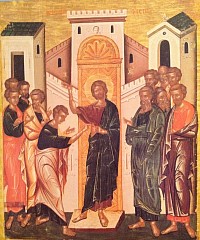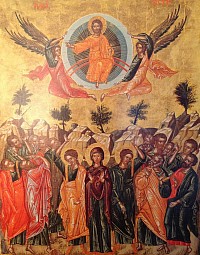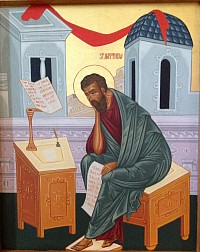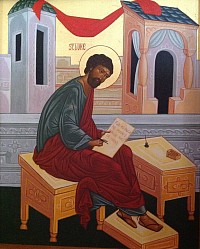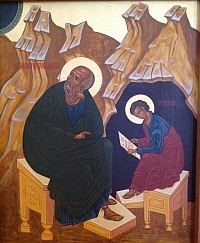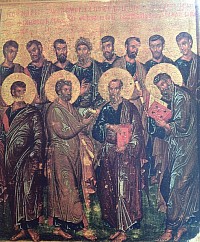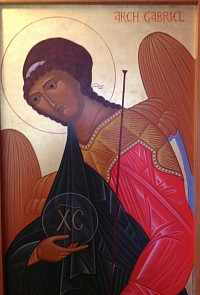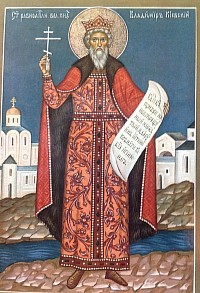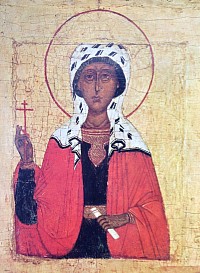Gallery
St Thomas
St Thomas, or Didymus, is recorded as doubting sceptically the Resurrection. Jesus appeared to the Apostles and invited Thomas to touch the wounds to provide evidence enough for Thomas to believe. Thomas is reported to have been so convinced, that in AD 52 he travelled as far as Kerala in India to bring news of the Messiah to the Jewish community there who were part of the Diaspora. By all accounts he was a charismatic figure and throughout that part of the world grew communities which followed Christianity. He is believed to have died AD 72 on 21st December.
The Ascension
Christian Theology asserts that forty days after the resurrection Christ ascended into Heaven. It is central to Christian belief and is included in all the Creeds. Forty days echo the forty days in the wilderness. It must be remembered however, that in Jewish literature the term forty days is often used to denote 'a long period of time' and not necessarily intended to depict an exactperiod of chronology. Whilst tradition asserts that Jesus ascended into heaven after forty days, the period of time between his resurrection and ascension doesn’t mean that it was forty days not a day less nor a day more. Modern emphasis on journalistic accuracy was, at the time the gospels were written, not the case.
St Mark
Traditionally believed to have been born in Cyrene in what is now Libya, the year of his birth is unknown. Commentators record he was John Mark, John being the Jewish component of his name and Mark being the name to which he answered after joining Christ as a disciple. It is believed his mother was an eager follower of Christ, and opened her house for use after the resurrection. Some believe that it was her house in which the Last Supper was held. He travelled widely to places including Egypt, Libya and Pentapolis. He became the first bishop of Alexandria in Egypt, and it was in Alexandria that pagans tied a rope round his neck and dragged him to his death. Mark is one of the leading saints in the Coptic Orthodox tradition.
He is traditionally believed to be the author of the gospel that bears his name, having based his knowledge on what he had heard from the Apostle Peter. Mark served as an assistant to Barnabus and Paul on their travels. The term denoting assistant huperetenis rather vague and we don't know in what capacity he helped. Later he is seen as a companion to Paul and later still with Peter. A lot of what we have recorded about Mark is either vague or contradictory by comparison to what we know of other prominent figures. Early sources link him to being a Jewish Priest as he came from the line of Levi. Eusebius and Adamantius remark that Mark wasn't actually a member of the disciples at all, yet later tradition allocate Mark to being one of the 72 disciples. Hyppolytus and others refer to Mark being "stump fingered", the belief being that Mark mutilated is fingers to make him unfit to continue to perform Priestly duties. The exact year of his death is also vague, but the best guess is around AD 68.
St Matthew
Matthew, a tax collector, possibly for Herod Antipas, and originally named Levi, was recruited by Jesus and became one of the Apostles. He was born in Galilee, which at the time wasn't part of the Roman province Idaea or Judea. Matthew collected taxes for the Romans and became, like his colleagues, fairly despised. Tax collectors were not paid. They paid to the government a set amount, and whatever they collected above this was their payment. Therefore, it was in their interest to collect as much as they could, to get as rich as they could. Similarly, prefects such as Pontius Pilate were required to remit a certain sum to Rome and whatever they could collect over and above this was profit. It is obvious why Matthew was an outcast.
Matthew would have had to be literate in both Aramaic and Greek to do his job, so he must have been a literate intelligent man. In what today is Algamor, Jesus called Matthew and joined him for a meal. Ever critical of Jesus, the Scribes and Pharisees took Jesus to task for eating with Matthew as he was deemed by his profession to be automatically a sinner and outcast. Jesus was crushing in His reply by saying He didn't come to call the righteous but sinners.
Scholarly opinion is divided as to whether Matthew was the author of the gospel named after him. What is known is that Matthew, a witness to the ascension, travelled far afield to proselytise and it could well be that some, if not all, of his gospel was written by him, or at least one of his followers. He is said to have died in Ethiopia under the edict of Fulvian, who had him burnt alive, though other sources would have us believe he was stoned to death or beheaded. Irrespective of how he died, we can be certain that he did, indeed, die.
St Luke
Luke is probably an abbreviated version of the name Lucanus, a name unknown before the 1st Century. Luke was a probably a Greek Gentile and not a born Jew, although he had a wide knowledge of the Septuagint either as a Jewish proselyte, or after he became Christian. Luke came from the city of Antioch in Syria, which at the time was heavily under the influence of Greek thought. He is believed to have been a physician (i.e. not a surgeon but one that prescribed medicine) and was widely travelled, quite possibly working as a doctor aboard ships. He was a bachelor and a disciple of Paul. It might have been the case that at some point he had a residence in Troas, though this is not clear. As a doctor, like Matthew, he would have been an intelligent and literate man. It's commonly held that he was the author of the gospel that bears his name and also the Acts of the Apostles, and he probably had a hand in some of the authorship of Hebrews, but in truth this cannot be conclusively concluded. The earliest manuscript copy of the gospel can be dated to AD200 and it is the attribution attached to this that has designated Luke to be the author. After the death of Paul, he is believed to have travelled to Italy, Dalmatia, Macedonia, and other regions.
He is believed to have died at 74 or 84 in Thebes, in the region of Boeotia, Greece. It is believed he was tortured then hanged from an olive tree.
Saints John the Theologian and St Prochor
St John the Theologian refers to the Apostle John, writer of the fourth gospel. The youngest of the apostles and possibly closest to Jesus. His parental attribution is said to be Salome his mother (who, tradition has, was one of those who arrived with myrrh to anoint Jesus after the crucifixion) and Zebedee, a fisherman. A James was his younger brother. There was an especially close relationship between John and Jesus which is acknowledged often in the gospels. One can only speculate why Jesus referred to the pair collectively as "Boanerges" (translated "sons of thunder") but fiery tempers seems to be the obvious one.
He is often thought to be to be the same John who is referred to as John the Evangelist and John of Patmos. Tradition indeed ascribes John as being the author of one gospel, three epistles and the book of Revelation, however, since as early as AD 600 there have been doubts that the same person wrote all five documents with John the Elder being thought of as the author of two of the epistles and the Revelation being considered as the work of Justin Martyr and Irenaeus. Modern scholars, upon examination of the style, grammar and vocabulary, strongly suggest that the three Johns mentioned above are in fact three different people. The dating of the gospel has received much attention, from it being written between AD 65-85, to maybe being written as late as Ad 90-100.
Tradition is divided as to whether he died in Jerusalem or on Patmos, but, however the dominant theory is that he ended his days exiled by Diocletian on the island of Patmos around AD 90-95, where it is said he received the series of visions set out in the Book of Revelation.
St Prochor is believed to be the name of a pupil and companion, who, it is said, spent much of his time writing down what John needed him to record and assisting him in his infirmity.
Saints Peter and Paul
Peter and Paul are central to the spread of Christianity after Jesus death and resurrection.
Peter was the son of Jona and was born in Bethsaida in Galillee, (where also St Philip lived) he was an apostle alongside his brother Andrew and is remembered as the first bishop of Rome. By the time he met Jesus he was married and living with his wife and mother in law in Capernaum. He was a wealthy man who owned his own boat. He was influenced by the message of John the Baptist and was thus ripe for when Jesus called him. Subsequent to the Ascension Peter returned to Jerusalem and became a prominent character in the community of Jesus' followers, taking the lead in spreading the message. In time he left to spread the message further afield, most particularly in Lydda, Joppa and Caesarea before returning to Jerusalem. There he resumed his position at the head of the Christian community till the arrival of the first Herod Agrippa AD 42-44. Herod set about a persecution of Christians and laid Peter in prison intent upon his execution. Peter escaped and left the area, leaving the Jerusalem community in the hands of James, but little is known where exactly he went. In the second year of the reign of Emperor Claudius he went to Rome and overthrew Simon Magus to hold the Bishops position till his death under Emperor Nero The date of his death by martyrdom isn't known, but various scholars have narrowed it down to AD 64-68. The place of his death is said to be the site of the Neronian Gardens where now the Vatican stands. Emperor Nero was a particularly sadistic executioner, and these gardens were is particular playground of cruelty. Tradition holds that Peter died by upside down crucifixion. Peter wrote two epistles, and the Gospel of Mark is also ascribed to him (Mark was his disciple and interpreter).
Paul is so well known, it is almost redundant to say more. He was what would now be termed a Turk, being born in Tarsus, and was, before his conversion, an enthusiastic Pharisee devoted to the destruction of Christianity. He was born in Tarsus in Cilicia, of pious Jewish parents. He was named Saul as he was a descendant of the Tribe of Benjamin in memory of the first King of the Jews. As a young man he studied in Jerusalem under Gamaliel His trade was that of making tents, or rather, making the mohair from which tents were made.
He was active and determined to persecute those preaching Christianity, and he is believed to have cheerfully and helpfully acted as cloakroom attendant so that those who wanted to stone Stephen to death could do so unimpaired. He dragged people from their homes who he believed to be Christian and had them tortured and killed. His conversion however, was dramatic and sudden and he became as zealous a follower of Jesus as he had been an opponent.
He was responsible for much of the development of Christianity in and around the Mediterranean Basin. After the death of Jesus, both Paul and James took the dominant role in influencing what was to become Christianity. James adhered fairly closely to the Judaic traditions in his thinking, whereas Paul had different ideas. Through his influence, he relaxed the Judaic expression of Christianity and made it easier for Gentiles to be welcomed into this new religion. James took the line that to follow Jesus, being a devout Jew, automatically meant that believers should believe what Jesus believed and to stick to the way of life that Jesus embraced. There was lack of enthusiasm among Gentiles to the full extent of this message, particularly to circumcision, which is where Paul's message succeeded. Paul saw that to sell the message of what was later called Christianity, those spreading the message had to take a less rigid line on certain things. As such his influence on Christian thinking and attracting believers cannot be underestimated. He died as a martyr in Rome around AD 62-64.
He remained faithful and observant to the Torah throughout his life, taking to a Mikvah after he converted and stating that Gentiles should obey the commandments set out in the Torah. He continued to make Jewish sacrifices in the Temple throughout his ministry and continued to keep the Jewish Festivals. So rather than turning his face from his tradition of Judaism towards Christianity, he continued living the Jewish life and sought Gentiles and fellow Jews to follow the example of Jesus, who Himself was a Jew and Who besought people to obey the commandments.
The Feast day of both saints is marked on June 29th
Synaxis of the Twelve Apostles
This ikon presents the twelve apostles. Peter, Andrew, James (son of Zebedee) John, Phillip, Bartholomew, James (son of Alphaeus) Thomas, Matthew, Simon, Mark, Thaddeus and Paul who replaced Judas in ikonographic portrayal.
Of the apostles, Peter, Andrew, James, John, and possibly Philip were commercial fishermen. Much has been said of these that Jesus chose "poor fishermen", but this isn't borne out by archeology. Far from being poor, it is quite probable that Peter, Andrew, James and John were in fact wealthy men. To be a commercial fisherman in 1st Century Israel meant that they would have had at least one boat, possibly more, and each boat would have needed an employed crew of at least nine. Archeology has determined that commercial fishing boats were large vessels crewed by eight oarsmen. This meant that they would have been navigated by one other and possibly had yet others to work the catch. This makes Peter, Andrew, James and John well off business men with a social status far higher than many have attributed to them. This explanation at least accounts where much of the money came from which Jesus and the disciples needed to conduct their mission.
Neither Jesus nor the apostles were a ragged rough rag-tag & bob-tailed crew of "rude mechanicals" as many would have us believe. Their social status was pretty high amongst their contemporaries, Middle Class even, and this was necessary because Jesus need to have people around Him to whom other people would pay attention. As a carpenter, and the son of a carpenter, Jesus was most certainly wealthy Middle Class, as in 1st Century Israel, carpenters were akin to structural engineers of today.
St Andrew the Apostle.
Andrew was a fisherman by trade, born in Bethsaida. His brother was Simon Peter and at the time they met Jesus they were living together in Capernaum. Andrew was a disciple of John the Baptist (known in Orthodoxy as John the Forerunner) but when Andrew met Jesus he left John to follow Jesus, and convinced He was the Messiah, introduced his brother to Jesus.
After Pentecost it is believed Andrew set off on his travels which took him over many miles. He is believed to have preached in Skythia, along the coast of the Black Sea and the Dnieper River to Kiev. From there he travelled to Novgorod, where tradition holds, he established the See of Byzantium (Constantinople) installing Stachys as it's first bishop. His influence spread to Thrace, Peloponnese, Greece and Epirus increasing the number of Christians and clergy. He also travelled to Georgia from Ajara via Atsquiri and established a church there, and in Kiev legend says he prophesied 'that the city would have many gold domed churches'.
Andrew ended his days in Patra in Achaea on the northern coast of the Peloponnese in AD 62. Andrew succeeded in convincing the family of the ruling Proconsul, one Ageates by name, of the Christian message. The Proconsul himself was however enraged by this and ordered Andrew's death. Thus he was tied to a cross in the saltire form, as an X shape, where he was tortured to death. Death by crucifixion would not have taken place as the conditions necessary for such a death don't exist in the saltire design.
Archangel Gabriel
No Christmas would be complete without the story of Archangel Gabriel turning up 9 months beforehand to tell Mary she would be pregnant. Angels are deemed to be Messengers of God, (El being the component in both Michael and Gabriel that refers to Elhoim. In Jewish scripture God is referred to in various ways, the two most common being Elhoim and YHWH. When used, YHWH refers to the God of the Covenant - between God and the people of Israel - and Elohim is used when the meaning is God of Creation). In the pantheon of angels Michael and Gabriel are at the zenith. Gabriel ( גַּבְרִיאֵל ) appears only twice in the scriptures, once in Daniel and again in Luke. Daniel doesn't explicitly refer to Gabriel as an angel but in the visionary sense a messenger, whereas the story of the Annunciation places Gabriel in bodily form. Tradition over the years has developed Gabriel and Michael into figures far greater than those found in the scriptures.
Archangel Michael
Archangel Michael ( מִיכָאֵל ) has an elevated place in the hierarchy of the Christian tradition of angels. As with Archangel Gabriel, a messenger, the name Michael meaning in Hebrew 'Who is like God', and in Jewish literature and tradition Michael also occupies a special place. Daniel has a visionary experience of Michael and in the book of Revelation Michael appears there. It was St Basil who elevated Michael to the position of ARCHangel, and early Orthodox tradition ascribes him "Archistrategos", or "Supreme Commander of the Heavenly Hosts". Orthodoxy recognises that God extends His activity to the world by means of which we have no idea, and in the Liturgy we attend to this idea in the use of the term "Bodiless Powers". Shakespeare alluded to such things when he placed into Hamlet the words "There are more things in Heaven and Earth, Horatio, than are dreamt of in your philosophy".
King David
Both Matthew and Luke were writing predominantly for a Jewish readership, and in Judaism, your credibility was determined by who your ancestors were. Luke was keen to demonstrate to his Jewish audience that the Messiah had arrived, and with this in mind he laid down a demonstration that Jesus was a direct descendant of David.
David was born in Bethlehem, the youngest of eight sons of Jesse and great grandson of Boaz and Ruth. He is believed to have been born around 1085 BC and died in his 70th year in 1155 BC (though other theories put it all 30-50 years later). He was the second king of the two kingdoms (Judea and Israel) united in monarchy and whose reign over Judea took him from 1055 - 1047 BC, and over both kingdoms from 1047 - 1015 BC. He was a passionate man who sometimes got life catastrophically wrong. He was intent upon claiming the kingdom of Israel and ridding the land of the plague of Philistines making Israel an independent state for the first time. Early in his rule he captured the Jebusite city of Jerusalem and organised the arrival there from Cariathiarim the Ark of the Covenant, making Jerusalem the centre of Jewish worship and of Israel its political centre. It still is.
When he became King it is said by some sources that there were 339,600 men under his command. At the census1,300,000 were enumerated capable of bearing arms. A standing army, consisting of twelve corps, each 24,000 men, took turns in serving for a month at a time as the Jerusalem garrison. The administration of his palace and his kingdom demanded a large retinue of servants and officials. David exercised the office of judge, though Levites were later appointed for this purpose, as well as other minor officials.
After the Ark of the Covenant had been brought to Jerusalem, David undertook the organisation of religious worship. He wrote many of the psalms to be used during worship, and the sacred functions of the liturgy were entrusted to 24,000 Levites; 6,000 of these were scribes and judges, 4000 were porters, and 4000 singers. He arranged the various parts of the ritual, allotting to each section its tasks. The priests were divided into twenty-four families; the musicians into twenty-four choirs. Preparatory to building a proper temple (it was held in a tent during David's reign) David began to acquire treasures and materials, and describing to his son Solomon a plan for the building and all its details.
He is shown as a just monarch and prophet with a talent for writing, capable of being a warrior king when called upon. Strategically he was either very lucky or very clever.
Luke had to take great pains therefore, to establish that Jesus was a direct descendant of David, which is why the gospel opens with the chronology it does. What isn't clear though, according to some commentators, is why, if the expected Messiah had to come down the Davidic line did Luke draw the line down the maternal route ending at Mary, instead of drawing it down the paternal line ending at Joseph. According to Jewish tradition and law, the Messiach had to come from the Davidic line, and genealogy cannot transferred by marriage, so either Jesus wasn't the Messiach because he was born of a virgin, or he was the Messiach and Joseph was His natural father.
During the Diaspora while Romans were killing as many Jewish men as they could, it was established that the blood line should come down maternally so the Jewish nation wasn't wiped out, but in awaiting the Messiah it was the paternal line that mattered. According to ancient Jewish tribal law, the Messiah must come from the Tribe of David down the paternal line. Joseph was of the Davidic line, not Mary, and as Joseph was only betrothed to Mary and not united in marriage, Jesus wasn't actually at the time of His birth (following the tradition of the story of the virgin birth) from the Davidic line because He wasn't related to Joseph. The only way that Jesus could have come from the Line of David is if Jospeh and Mary were married, not betrothed, at the time.
Luke would also have known that to his audience, the Messiah (Maschiach Heb.) means 'Anointed', and that this was different from 'Saviour' (MoshiahHeb.) and that the Anointed One was to be a political leader descended from King David, well versed in the Law and the Prophets, devout, and be a charismatic leader. Characteristics which are easily argued that Jesus had.
Clearly this is a little difficulty which later editors to the gospels may have not considered, but, this is the reason why King David appears in the Orthodox tradition. He was, is, and will always be a VERY important man.
If you are interested, further information and his full biography is here.
St Anastasia of Sirmium
Little fact is known of this woman, except she died during Diocletian's persecution of the church. Stories emerged of her several centuries after her death, and their reliability cannot be relied upon to be accurate. Popular legend would state that Anastasia was the daughter of Praetextatus, a Roman vir illustris, and had Chrysogonus for a teacher. Early in the persecution of Diocletian, the Emperor summoned Chrysogonus to Aquileia, where he was martyred. Anastasia, having gone from Aquileia to Sirmium to visit Christians there, was beheaded on the island of Palmira on Christmas day. The dates of her birth and death are not recorded.
St Paraskeva of Iconium
There are three Orthodox saints going by the name Paraskeva. Outside Orthodoxy Paraskeva isn't widely known, but within Orthodoxy the Paraskevas are very important saints. This ikon is of paraskeva of Iconium. According to tradition, she was the daughter of a pious wealthy family who named her "Friday" (Paraskeva is Friday in Greek) after Good Friday. After her parents died she gave away all her wealth to the benefit of the poor, and set out on the stump to preach Christianity to anyone who would listen. In time she became an enthusiastic evangelical and was summoned to Emperor Antonius Pius. There follows a rather doubtful and dubious account of a lengthy and brutal interrogation where she was thrown in a vat of boiling oil and pitch, to which she responded without pain nor physical injury. She threw some of the pitch into the eyes of the Emperor and blinded him, and then healed him. This was enough to persuade Antonius to end the persecution of Christians. Continuing her missionary work she was thrown by one Governor Asclepius into close proximity with a "serpent". Paraskeva made the sign of the Cross over it and it died, whereupon Asclepius was also converted to Christianity. She either died, as did many others, under the Diocletian persecution, or she died by beheading under Tarasios, a city ruler.
History seems uncertain whether there were more than one Paraskeva. There are arguments that Paraskeva is an amalgamation of several people, and arguments she was one figure. To settle the matter attempts have erred on the side there were more than one and other Paraskevas have featured in Christian history, but irrespective of the true answer to this question her personality and strength of character was such that after her death she attracted a huge following.
She is invoked by those with diseased cattle, and those who are ill themselves.
